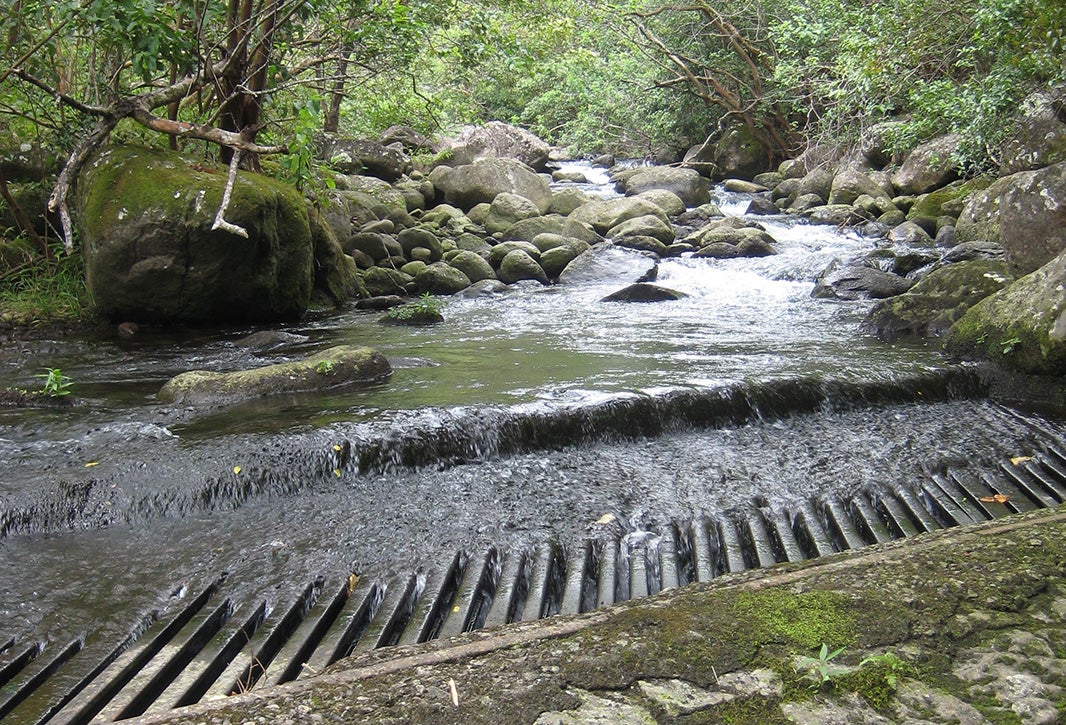Restore Stream Flow
Water in Hawaiʻi is a public trust resource, protected under the state Constitution and Water Code. Plantations diverted many Hawaiian streams to water sugar cane and pineapple fields, drying out and destroying the native life and Hawaiian communities connected with those streams. Now that plantations are in decline, the water can be restored to the

Water in Hawaiʻi is a public trust resource, protected under the state Constitution and Water Code.
Plantations diverted many Hawaiian streams to water sugar cane and pineapple fields, drying out and destroying the native life and Hawaiian communities connected with those streams. Now that plantations are in decline, the water can be restored to the native streams.
Government agencies, including the Water Commission, have a duty to protect and restore ecological uses, traditional and customary Hawaiian practices, recreation, and scenic values.
Hui o Na Wai ʻEhā and Maui Tomorrow, represented by Earthjustice, are working before the state Water Commission and in the courts to uphold the public trust, stop wasteful water diversions, and restore the Waiheʻe, North & South Waiehu, and Waikapū Streams, and Wailuku River (also known as ʻĪao Stream). Together, these waterways are traditionally known as “Nā Wai ʻEhā” or “The Four Great Waters” of Maui.
See major milestones in the fight to restore Nā Wai ʻEhā.
Legal Cases & Victories
- Historic Restoration of Waiʻaleʻale Water on Kauaʻi Heads to Litigation:
On Aug. 21, 2018, the Hawaiʻi Commission on Water Resource Management considered a historic proposal to restore flows to Waiʻaleʻale and Waikoko Streams on the island of Kauaʻi, but the Commission’s deliberations were cut short when Kaua‘i Island Utility Cooperative requested a contested case, initiating formal legal action before the agency. The two streams in dispute flow directly from Mount Waiʻaleʻale, a place of paramount sacredness in Hawaiian culture, but have been diverted for almost 150 years by plantations and are now diverted by KIUC to run two small plantation-era hydro plants. The dispute over appropriate instream flow levels will now be resolved in an adversarial trial-like proceeding before the agency. Kauaʻi community group Hui Hoʻopulapula Nā Wai o Puna, represented by Earthjustice, stepped in with its own request for a contested case in response to KIUC’s request. The Department of Hawaiian Homelands also requested to participate. (More details.) - Flows Restored To Waimea River And “Grand Canyon of the Pacific”: The State of Hawaiʻi’s Commission on Water Resource Management approved a historic agreement on April 18, 2017, that resolves a complaint Earthjustice filed in July 2013 on behalf of community group Pōʻai Wai Ola/West Kauaʻi Watershed Alliance to protect the “Grand Canyon of the Pacific” and restore stream flows to the Waimea River on Kauaʻi Island. Under the agreement, tens of millions of gallons of water each day will be restored to the Waimea River and its headwaters, and no diversion will ever be a total diversion again.
- Turning the Tide of History for Wailuku River and Waikapū Stream: Under a settlement approved by the state Commission on Water Resources Management in April 2014, the two companies diverting waters, Wailuku Water Company and Hawaiian Commercial & Sugar, agreed to restore up to 10 million gallons per day (mgd) to Wailuku River (also known as ʻĪao Stream) and 2.9 mgd to Waikapū Stream. On October 13, 2014, water returned to the two streams that had been diverted for more than 150 years.
- Maui Streams Flow Again: After years of essentially being drained dry and left for dead, two legendary streams on the Hawaiian island of Maui—Waiheʻe River and Waiehu Stream—came back to life. Fresh clean water from West Maui’s mountains is once again flowing to the sea, breathing life into the plants and animals along the way. (August 16, 2010)
- Citizens And County Of Maui Settle Lawsuit Over Streamwater Treatment Plant: The County of Maui and Maui community groups Hui o Na Wai ʻEha and Maui Tomorrow Foundation, Inc., represented by Earthjustice, announced the settlement of a lawsuit challenging the Environmental Impact Statement (“EIS”) for a proposed water treatment plant that would take water from streams that are under dispute in an ongoing Maui water rights case. (July 21, 2010)
- Central Maui Stream Restoration: Earthjustice petitioned the state Commission on Water Resource Management to establish instream flow standards that would sustain beneficial instream uses, such as ecological protection, Native Hawaiian practices, recreation, and scenic values in Central Maui. (July 6, 2010)
- Returning the Water to Nā Wai ʻEhā: A proposed decision by the Water Commissioner of Hawaiʻi would restore 34.5 million gallons a day to Nā Wai ʻEhā, about half of the diverted flows. (January 29, 2010)
- Settlement Will Help Restore Maui Streams: In December 2005, Earthjustice—on behalf of two Maui community groups, Hui o Na Wai ʻEhā and Maui Meadows Homeowners Association—announced a groundbreaking resolution of litigation over ground water from the ʻĪao aquifer. (August 31, 2006)